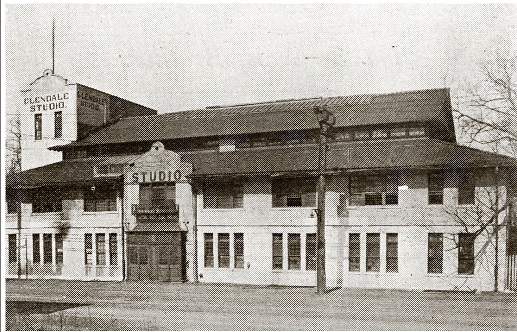As mentioned in previous issues of the Juniper Berry, picnic parks were ubiquitous in the Maspeth-Middle Village-Glendale-Ridgewood area at the turn of the 20th century. It’s hard to imagine now, but there was a bounty of undeveloped land on which to site these large parks.
One of the parks was Riebling’s Greater New York Park Dancing Pavilion (later known as the Glendale Casino Park), located on Myrtle Avenue in Glendale, just east of Schuetzen Park, which was featured in the March 2016 Juniper Berry. However, by the start of WWI, the popularity of picnic parks began to decline. In 1915, the park was sold to a surprise venture: a movie studio.
The earliest motion pictures were made in the 1890s, and by the 1910s, there was a frenzy to crank out as many of them as possible. Audiences couldn’t watch them fast enough and were demanding more. Theaters were being constructed at a breakneck pace across the country. At this point, the filmmaking industry was centered in New York.
In October 1915, Mirror Films was incorporated by prominent businessmen for $2,500,000. They had sought a location with a building that could be converted into an indoor studio to rent out to filmmakers. The Greater New York Park property was chosen as it contained a large 80’ x 130’ dance hall with a 25’ ceiling height which could be repurposed as a studio and its surrounding 2 acres of land could be utilized for outdoor scenes.
An ad published in newspapers on October 31, 1915 encouraged investment in the studio project. The company’s offer: “with each share of 7% cumulative preferred stock, you get as a bonus one share, free, of common treasury stock.” The ad listed the company’s main office address as 16 East 42nd Street in Manhattan but contained an illustration of the impressive looking Glendale studio building.
By March 1916, the studio was in operation. As film was still relatively new, producers turned to stage actors to star in their pictures. A photo taken on the first day of work at Mirror Studios featured Broadway veteran, Nat C. Goodwin and actor, playwright, producer, and stage and film director, Lawrence Marston preparing for action.
In April 1916, the company purchased 9 2/3 additional acres of adjacent property to facilitate the construction of huge outdoor sets. The boundaries of the combined properties were as follows: 548 feet of frontage along Myrtle Avenue between Schuetzen Park and Trotting Course Lane (now Woodhaven Blvd), just north of Forest Park on the Montauk and Rockaway divisions of the LIRR.
As of June 1916, the studio employed 49 full-time workers, and had plans to eventually hire 1,500 workers, which would serve as a boon to area employment.
Mirror’s first major films were produced by the Empire All Star Company. Richard Koszarski, in his excellent book, Hollywood on the Hudson, lists Albert Capellani's American Maid, Dell Henderson's Please Help Emily, and The Unforeseen, starring Olive Tell and David Powell, as having been shot at Mirror Studios in 1917. In 1919, the American Cinema Corporation filmed The Inner Voice there. The last major commercial films to be shot at Mirror Studios were the 1922 Film Guild productions of The Cradle Buster and Second Fiddle, both starring Glenn Hunter in the lead roles.
These films generally were successful, but business at the Glendale location never lived up to its potential. The moviemaking trend was to head out west, to Hollywood, where there was fair weather year round and a lot of land on which to build sets. After WWI, filmmakers showed less interest in Mirror Studios. Its major tenant by 1922 was C. C. Burr, a low-budget producer of comedy shorts. By the end of 1923, Burr had purchased Mirror Studios. Burr, with director Gregory La Cava, produced the following shorts at Glendale: The Four Orphans (1922), Sure Fire Flint (1922), Luck (1923), Restless Wives (1924) and The New School Teacher (1924). Burr’s tenants included Ernest Shipman, who produced The River Road and T. Hayes Hunter, who produced The Sky Raider (1925).
In May 1925, producer/director Whitman Bennett purchased the studio for $110,000 and renamed it the “Whitman Bennett Studio”. He had planned to make a few of his own movies at the facility while also renting it out to other filmmakers. However, Hollywood on the Hudson reveals that the only film he made at Glendale was Share and Share Alike (1925) starring Jane Novak. Tenant producer Herman Jans shot Ermine and Rhinestones (1925) there and that is believed to be the last production to ever come out of the Glendale studio. New York moviemakers were migrating to Hollywood at a rapid pace. The film business that remained in New York was very competitive, and the owners of the Glendale studio never made enough money to invest in upgrades, rendering the facility obsolete.
The complex soon became the Glendale Palace (later Sportland), an entertainment venue that contained a skating rink, bowling lanes, basketball courts, and a dance/banquet hall. In 1933, all of it was condemned and demolished to make way for the Interboro Parkway, today known as the Jackie Robinson Parkway.
Things have come full circle, however. Ninety years after what seemed to be a permanent move to the west coast, filmmaking has returned to New York with a vengeance, with more TV series now filmed here than in Hollywood. And Glendale is also again known for being home to a film studio – Broadway Stages on Cooper Avenue.




